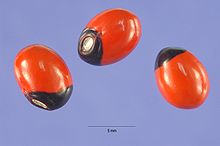Ratti(Sanskrit:raktika) is a traditionalIndian unit of measurementfor mass. Based on the nominal weight of aGunja seed(Abrus precatorius), it measured approximately 1.8 or 1.75grains[1][2]or0.1215 gas standardized weight.[3]It is still used by jewellers in the Indian Subcontinent.
| Ratti | |
|---|---|
 Gunja seeds (Abrus precatorius), used for measuring weights in India. | |
| General information | |
| Unit system | Indus Valley civilization,Mahajanapadas,Arthashastra,Mughal empire |
| Unit of | mass |
| Conversions | |
| 1in... | ... is equal to... |
| SI units | 0.11339g |
History
editRatti-based measurement is the oldest measurement system in theIndian subcontinent,highly favoured for its uniformity of weight. The smallest weight in theIndus Valley civilization,historically called themasha,was equal to 8 rattis.[4]The Indus weights were the multiples of masha and the 16th factor was the most common weight of 128 ratti or 13.7 g.
A unit calledŚatamāna,literally a "hundred standard" or "hundred measures", representing 100krishnalasis mentioned inSatapatha Brahmana.A later commentary onKatyayana Srautasutraexplains that aŚatamānacould also be 100 rattis. A Satamana was used as a standard weight of silver coins ofGandharabetween 600–200 BCE. Ratti is also known for its attractive colour.[5]Other Indian currency weights likeKarshapanaswere also based on the weight of ratti. Gold coins excavated from southeast Asia have been analysed as following the ratti based weight system as well.[6]
During the period ofKautilya,the 32 ratti standard was called as Purana or Dharana which was in vogue before theMauryan empire,but Kautilya provides a new standard of 80 ratti called Svarna, which was widely adopted from that time onwards. The ball weights from jeweller's hoard discovered fromTaxilaconform to the 32 ratti standard also called Purana by Kautilya, while the Mathura weights (Dated from 1st century BC-2nd century AD) with Brahmi numeral 100 (100 svarna or 100 karsha) conforms with the new svarna standard.[3]
The Mughal empire employed Ratti as a unit of measure for the weight of precious stones such as diamonds. Around 1665 the Shah's son,Aurangzeb,showed adiamondto the famous jeweler and world travelerJean Baptiste Tavernier.At that time Tavernier wrote in his Six Voyages:
"The first piece that Akel Khan (Chief Keeper of the King's jewels) placed in my hands was the great diamond, which is rose cut, round and very high on one side. On the lower edge there is a slight crack, and a little flaw in it. Its water is fine, and weighs319+1⁄2Ratis, which makes 280 of our carats, the Rati being7⁄8th of a carat. "
Unit conversion
editThe following info provides the unit conversion from ratti to other units in traditional Indian system of measurements.
Jeweller's conversion
edit- 1Masha= 8 Ratti or 0.972 g
1 Tola = 12 Masha = 96 Ratti = 11.664 grams.
Hence
- 1 Ratti (sunari) goldsmith = 121.5 mg
- 1 Pakki Ratti (for astrological gemstones) = 1.5 x Sunari Ratti = 1.5 x 121.5 mg = 182.25 mg.
See also
editReferences
edit- ^Mukherjee, Money and Social Changes in India 2012,pp. 412–413.
- ^Cunningham, Coins of Ancient India 1891,pp. 22–23.
- ^abAllchin, F. R. (1964). "An Inscribed Weight from Mathurā".Journal of the Economic and Social History of the Orient.7(2): 201–205.doi:10.2307/3596241.ISSN0022-4995.JSTOR3596241.
- ^McIntosh, Jane (2008).The Ancient Indus Valley: New Perspectives.ABC-CLIO.ISBN978-1-57607-907-2.
- ^Mukherjee, Money and Social Changes in India 2012,p. 412.
- ^Borell, Brigitte (January 2017)."Gold Coins from Khlong Thom".Journal of the Siam Society.105:157.
Bibliography
edit- Cunningham, Alexander(1891),Coins of Ancient India: From the Earliest Times Down to the Seventh Century A. D.,London: B. Quaritch
- Mukherjee, B. N.(2012),"Money and Social Changes in India (up to c. AD 1200)",in Saiyid Zaheer Husain Jafri (ed.),Recording the Progress of Indian History: Symposia Papers of the Indian History Congress, 1992-2010,Primus Books, pp. 411–,ISBN978-93-80607-28-3